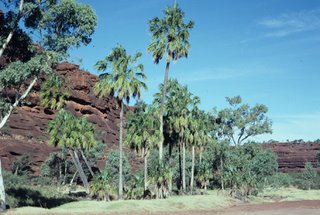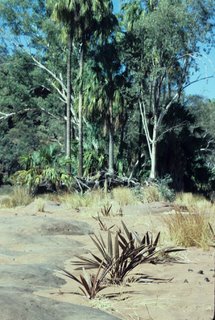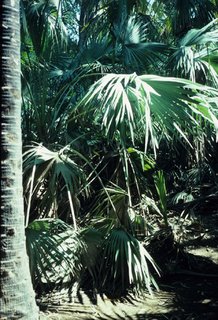 At Finke Gorge, SW of Alice Springs, one of the oldest rivers in the world cuts through sandstone ranges on its way to Lake Eyre. For 100 million years, the Finke River has meandered across the heart of the continent, while the scenery around it changed from forest to desert.
At Finke Gorge, SW of Alice Springs, one of the oldest rivers in the world cuts through sandstone ranges on its way to Lake Eyre. For 100 million years, the Finke River has meandered across the heart of the continent, while the scenery around it changed from forest to desert.Eucalypts and spinifex dominate the Centre now. But in Finke Gorge National Park they share space with relics from another time. Finke Gorge is caught between the wetter Then and arid Now.
 The cabbage palm Livistona mariae is restricted to this area. There is no other Livistona for a thousand kilometres. (The nearest occurrence is at Mataranka in the Top End.) But the closest relative—the sister species—of L. mariae is a palm from Fortescue River in the Hamersley Ranges of Western Australia, about 1200 kilometres to the west.
The cabbage palm Livistona mariae is restricted to this area. There is no other Livistona for a thousand kilometres. (The nearest occurrence is at Mataranka in the Top End.) But the closest relative—the sister species—of L. mariae is a palm from Fortescue River in the Hamersley Ranges of Western Australia, about 1200 kilometres to the west.  At some time in prehistory, when the Australian climate was more humid, Livistona was spread across much of the interior. (Perhaps Mataranka gives us an idea of how the Centre might have looked.) As the continent drifted northward, it began to dry out. Forest retreated to cool, damp sanctuaries in the rocky gorges. Then the climate beat them. The remnants of that ancient flora and fauna—not only palms, but cycads, snails and other invertebrates—survive in Finke Gorge.
At some time in prehistory, when the Australian climate was more humid, Livistona was spread across much of the interior. (Perhaps Mataranka gives us an idea of how the Centre might have looked.) As the continent drifted northward, it began to dry out. Forest retreated to cool, damp sanctuaries in the rocky gorges. Then the climate beat them. The remnants of that ancient flora and fauna—not only palms, but cycads, snails and other invertebrates—survive in Finke Gorge.